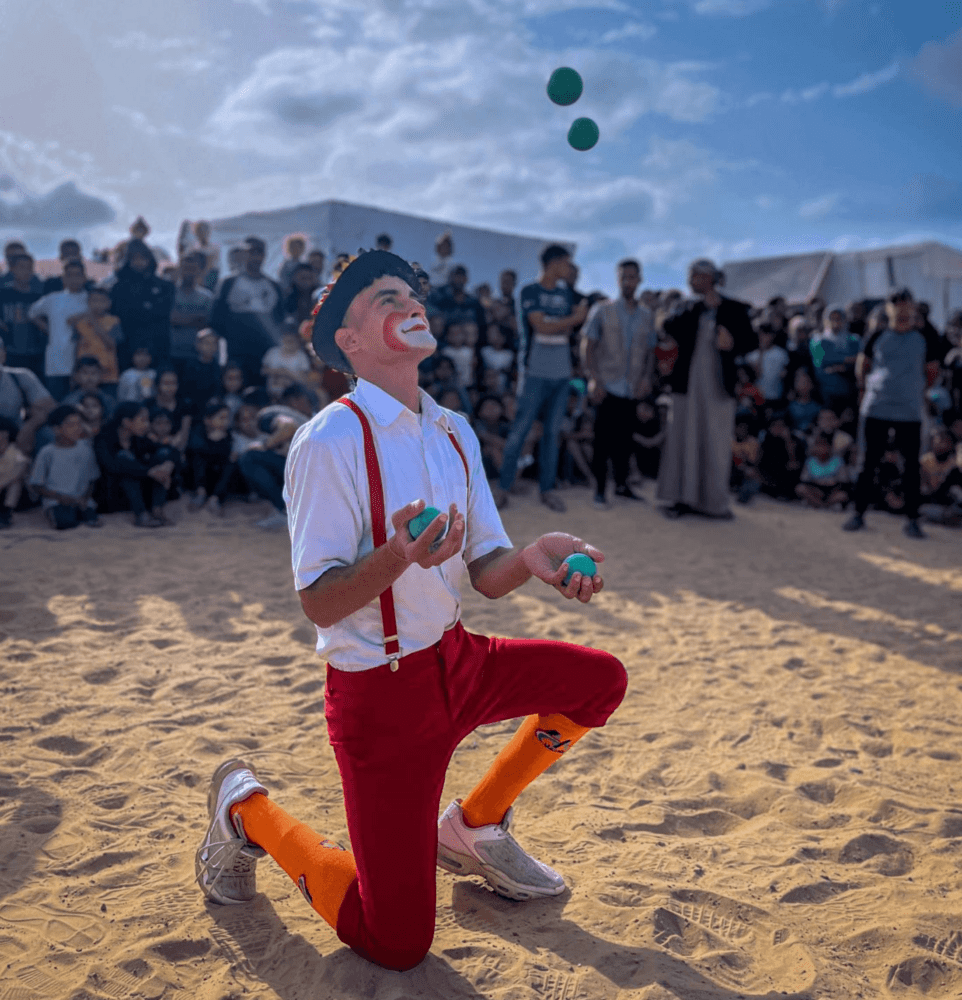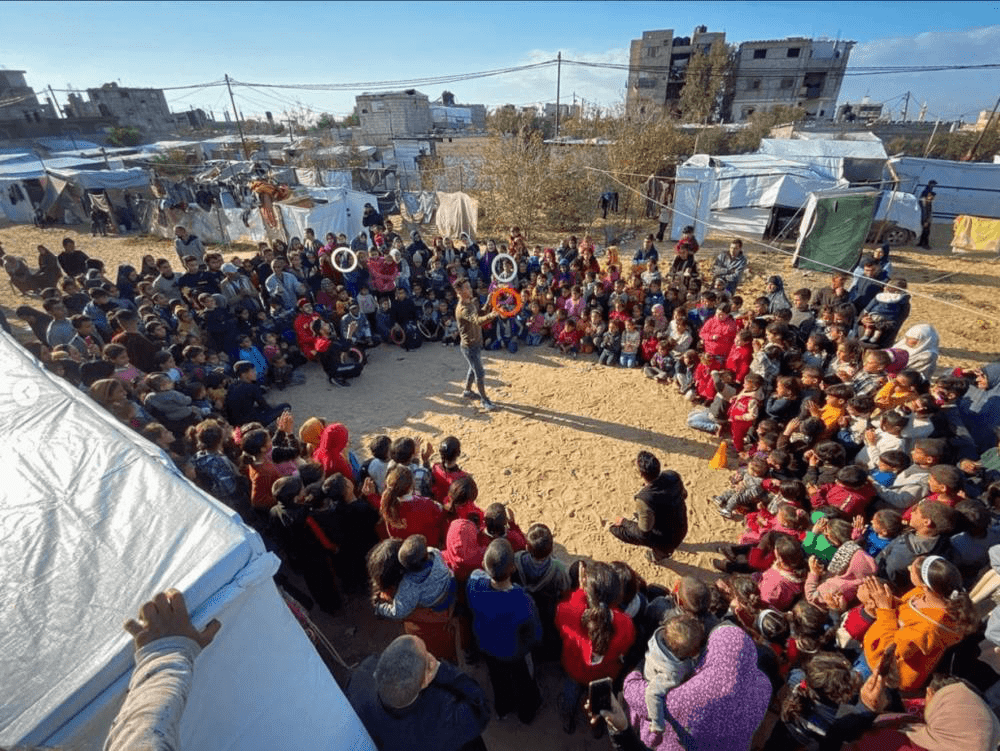Recently updated on October 5th, 2024 at 01:09 pm
As bombs rain down on Gaza, community-led groups are providing children with psychological first aid: play, support and laughter.
Zany: I know this piece is supposed to make me happy—laughing children enjoying themselves, but it did the opposite. The only thought I had while looking at these images was: “Media needs to plaster these all over the news.” I’m tired of people who act like Palestiniansm are all evil terrorists. No, they’re just like us and every other group of human beings in the world. We all enjoy laughing and having fun. I believe these images will pull even more people into the cause. Hearing that thousands of children are being killed can elicit an image of faceless children in your mind. Seeing the faces of these smiling, laughing kids would put real kid’s faces in place of the faceless “generic” people in a lot of minds.
So do me a favor, and share this on social media, or with a friend that doesn’t seem concerned about what’s going on in Gaza. Maybe we can change the hearts of people and bring them into the fight for a permanent ceasefire in Gaza. Thank you.
POSITIVE NEWS
It’s Eid al-Fitr in Gaza, a holiday period when – in happier years – Palestinians gather to celebrate the end of Ramadan in cheerfully patterned ‘Eid outfits’. The freshly bought clothes signify hope and renewal.
This, however, is a very different Eid. In a shelter in a school in Deir Al-Balah, a city in the centre of the Gaza Strip, the animated film SpongeBob SquarePants plays on the wall. The watching children nod and smile along to the antics of a sea sponge projected from a laptop onto a makeshift sheet drawn across the wall. This is a school where lessons have been paused for the past five months.
Israel’s war on Gaza began on 22 October, 2023, in retaliation for the 7 October attacks on Israel conducted by Hamas, a Sunni Muslim political and military movement that governs part of the Gaza Strip. Several of the children at the shelter in Deir Al-Balah today have been orphaned by the conflict. All have been displaced multiple times by aerial bombings and land assaults. Some have seen their parents taken away in front of their eyes by Israeli forces.
Each and every child is “deeply traumatised”, says Islam Badwan, coordinator of psychosocial support at Sharek Youth Forum (SYF), a grassroots Palestinian charity founded in 2004. He and colleagues are working on the ground in emergency response with partners the UNFPA (United Nations Population Fund) and US child neurodiversity nonprofit Project Hope Foundation. “The children we see are nervous all the time. They are sometimes violent. They have memory issues,” Badwan tells Positive News. “They also have problems that come from insecure food sources, as well as shame around the lack of sanitation and poor hygiene.”
A child is killed every 10 minutes in the current Gaza war, and the psychological impact on surviving children is profound. Effects range from heightened risks of anxiety, depression and self-harm; to psychosomatic effects from stress such as chest pains, difficulty breathing and speech impediments, as well as reactive aggression and post-traumatic stress disorder (PTSD). A systematic review of papers on the mental health of children and adolescents in the Middle East (predating the current war), found the prevalence of PTSD among Palestinian children to be between 23% and 70%.
In the days following the outbreak of war, SYF rapidly pivoted from education and girls’ empowerment programmes to providing food and healthcare aid alongside child and play-led psychological first aid (PFA).

PFA is designed to reduce the occurrence of post-traumatic stress disorder in the immediate aftermath of disaster and terrorism. First developed in 2006 by the United States Department of Veterans Affairs, it is an evidence-informed approach that focuses on eight ‘core actions’: contact and engagement, safety and comfort, calming and stabilisation, information gathering on current needs, practical assistance, connection with social support (such as community projects providing play), information on coping and links to professional help.
SYF, whose name translates as ‘your people’, had form in this regard, having an off-the-shelf emergency plan in place from the 2008-2009 Gaza war (Sharek Shaabak, or ‘help your people’). In that latter three-week armed conflict between the Gaza Strip Palestinian paramilitary groups and the Israel Defense Forces, 46,000 homes were destroyed and more than 1,400 Gazans died.
Taking inspiration from Hiroshima
“The children come to us and ask us for what they want,” says SYF’s project evaluation officer Sarah Anbar of the charity’s work in recent months. Alongside talking therapy it has also included staging volleyball tournaments, playing traditional Palestinian games such as the spinning game ‘bee and wasp’ and Al-Hjelle (hopscotch), and football matches at shelters led by Sunbirds, a group of amputee Palestinian sportsmen.


“The children tell us they want to watch movies, they want to play games and they want to do things that make them feel as normal as possible,” Anbar explains. The charity’s temporary classrooms programme, the Hiroshima-Gaza initiative, is inspired by the Japanese city Hiroshima – a city that endured the devastating effects of a nuclear bomb in the second world war yet went on to emerge as one of Japan’s most industrious and productive centres. With schools across Gaza closed, around two million Palestinian children are currently without formal education. The initiative offers weekly lessons in mathematics, Arabic, English and history to children in shelters. According to charity Unicef, more than 850,000 children are living in shelters across the territory of the Gaza Strip.
Dr Audrey McMahon is a psychiatrist for healthcare charity Médecins Sans Frontières (MSF) and supervises the charity’s mental health and psychosocial team in Gaza. She says the needs of children displaced in the current conflict are ‘gigantic’. “What children need most is physical, psychological and emotional security from loving adults,” she tells Positive News. “This is currently very challenging as everyone in Gaza, including adults, is under threat and unprotected.”
Research shows that children who have grown up in conflict zones suffer lifelong impacts on their physical and mental health, social wellbeing and development. Through clinics and hospitals, MSF is offering counselling and recreational activities to children, including play and storytelling. However, McMahon says that the work of grassroots Palestinian initiatives such as SYF are key as they promote a sense of belonging and create “some normalcy in a fragmented time” yet do so through the lens of Palestinian everyday life and culture.
What children need most is physical, psychological and emotional security from loving adults
At a tented camp outside Rafah, children clap in a circle as a trio of clowns perform somersaults and juggle balls and coloured rings. They go on to lead Zumba dances and joke behind their white face paint and comical bright red noses. “You brought joy for us and you made us forget the sound of bombardments,” says one smiling nine-year-old boy of the performance by Free Gaza Circus, one of the Palestinian grassroots initiatives cited by McMahon for its adaptive response to supporting the mental health needs of children in the latest war.
Free Gaza Circus (FGC) was established in 2018, and, like SYF, quickly adapted to the emergency situation. Many of its employees were displaced from their homes in northern Gaza in November 2023, to the southern city of Rafah (which is now itself under threat of bombardment). “Before the war we put on weekly performances and trained 250 Palestinian children in circus skills at our circus workshops,” says FGC’s co-founder Mohammed Khader over the telephone from Rafah.
Salah Abu Harbel, one of the circus’ most talented acrobats, was killed by an aerial bombardment in January. Despite the risks, Khader has now taken the project on the road. The team is distributing food parcels and cookies to children at tented camps that have sprung up in the desert and on the outskirts of Gaza City, alongside the cheer of traditional madcap circus performances and training. “Music and dance are tools to tackle PTSD and depression and to help make children feel safer,” Khader says. “Finding joy is the biggest psychological aid we have.”

Dr Nilofer Naqvi, psychologist and associate professor in psychology at Iona University, New York, notes that play-based psychological intervention for children in conflict areas is a growing area of focus and research. Naqvi cites Sesame Street’s collaboration with the International Rescue Committee in the Middle East and North Africa as one example. It uses puppet characters such as Jad, a boy who had to leave his home, and Basma, his gregarious new local friend, to help displaced children make sense of their lives via screened TV shows and in-person puppet shows.
Traditionally, she adds, play and leisure have been fringe considerations in conflict settings, where the primary focus is understandably on food, shelter and addressing physical trauma. Research conducted by charity War Child has found that simple play-based activities–such as the charity’s TeamUp project, which combines play and movement to release children’s pent-up stress–play a vital role in boosting children’s wellbeing in refugee settings.
Music and dance are tools to tackle PTSD and depression and to help make children feel safer. Finding joy is the biggest psychological aid we have
Naqvi however has mixed feelings about the now hegemonic concept of ‘psychological first aid’. She points to a recent paper by Michael Wessells, former co-chair of the United Nation’s IASC taskforce on mental health and psychosocial support in emergency settings, that highlights the harm that can be done by culturally blind PFA interventions. These include work to reintegrate child soldiers in Sierra Leone that excludes girls as it presumed former combatants were exclusively male; and counselling for survivors of sexual violence that identifies these survivors in the community and therefore increases the stigma they face. “What’s clear is that if PFA is offered, it needs to come from within the community, and incorporate contextually appropriate healing practices,” Naqvia adds.



Critics of the PFA approach also note that it has a limited evidence base around outcomes and that its focus on training bystanders can be to the detriment of ensuring enough qualified mental health professionals are available for long-term mental health support.
Helping children to feel safe, for at least a moment
On the opposite wall of the school shelter in Deir Al-Balah hangs a simple tapestry rendition of an olive tree. The tree has become a symbol of Palestinian identity, with the roots representing Palestinians’ ties to the land and the branches their displacement from this land. Named the Tree of Wishes by SYF’s workers, many of whom are themselves multiply displaced, children have stitched their wishes to the branches’ tips. Some read ‘Please stop the war, others, simply: ‘I would like to go home’ or heartbreakingly: ‘I would love a toy’ or ‘I would like a place to play.’ The project, Islam Badwan says, attempts to address the wishes that are within its power, even if the bombs continue to fall. “Each day that is passing without a real ceasefire, it costs us in our mental and physical health,” Sarah Anbar adds. “In the mental and physical health of Gazan kids.”
Mohammed Khader says that FGC now gathers athletic young Gazans into its travelling troupe as it moves around a war-battered Gaza, performing at UN relief sites, camps and shelters, many of which are located in disused schools. “I like it when the children’s faces light up when we perform for them,” he continues. “It takes their minds off the horrible violence that they have seen and suffered. In that moment they forget the bomb strikes and ruined homes. They forget the tears they have shed. At that moment they feel safe.”
Main image: Free Gaza Circus
This article was originally published on Positive.news and was republished here, with permission, under a CC BY-ND 4.0 license.








